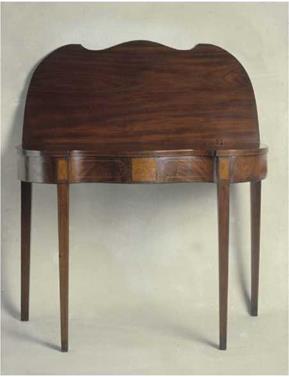 The British brothers Robert and James Adam were both edu-
The British brothers Robert and James Adam were both edu-
cated as architects. They developed a pronounced style after their return from Pompeii and other cities in Italy. Their work grew in popularity throughout England between 1760 and 1792 and had a profound effect on furniture styles in England and abroad, especially on the work of Hepplewhite and Sheraton. Their furniture was characterized by simplicity and delicacy. They designed sideboards, upholstered sofas, and daybeds, often using rectilinear forms. A vast collection of 9,000 drawings by Robert Adam are preserved at the Soane Museum, of which several hundred are drawings of furniture. In response to the growing interest in classicism, many of their furniture designs incorporated applied classical motifs, animal heads, human figures, floral swags, and pendants.
The English cabinetmaker George Hepplewhite (d. 1786) was influenced by the work of Robert Adams and Neoclassicism. His designs were lighter than those of Chippendale and were preferred by many for this reason (Figure 10.40). His Cabinet-
figure 10.40 American (Hepplewhite) card table (1800), mahog – Makers and Upholsterer’s Guide, published in 1788, featured
any. Courtesy of Cincinnati Art Museum. Gift of Mrs. William furniture with delicate elements, tapered legs, veneer and inlay
H. Chatfield. Accession No. 1956.358. work. This publication, along with Thomas Sheraton’s Cabinet
 |
 |
Maker’s and Upholsterer’s Drawing Book of 1791 and 1793, provided inspiration for many English and American furniture makers (Figure 10.41).
Many people were attracted to the ideals of classical ornament, giving the work of the Adam brothers a strong following. The main source of inspiration for the young United States came from Greece and ancient Rome. The Greek ideal was a preferred standard on which to cultivate a new society. Ancient Greece, as well as English and French neoclassical furniture, influenced furniture design in America during the earlier nineteenth century.


